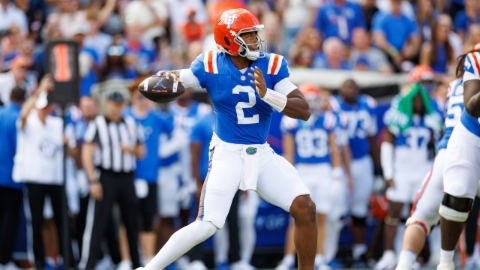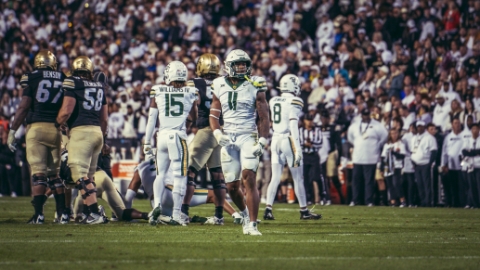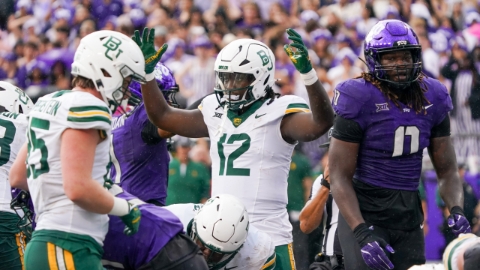
With Baylor gunning for a shot at the national championship, Seth Russell’s season-ending injury against Iowa State in 2015 was catastrophic- at least, it was once Jarrett Stidham also fell down under center a couple weeks later.
Baylor’s offense was operating at historic rates, and the string of injuries dashed dreams of a natty let alone a three-peat Big 12 title. Yet, short of hiring Matt Rhule as Art Briles’ long-term replacement, this may be the most pivotal string of events for Baylor this year.
Reason being, the college football world became better acquainted with the many running backs in Baylor’s stable. While there wasn’t much to do in Baylor’s two losses to close Big 12 play, the Russell Athletic Bowl rout over UNC made it clear there was young talent to keep an eye on.
In steps Terence Williams.
Of course, one would be crazy to call him the MVP of the game. That honor is for Johnny Jefferson for notching his first thousand-yard season after rushing for 299 yards and three touchdowns. Devin Chafin carried the ball 27 times as well, pushing through for a touchdown and 156 yards.
But behind those two, then redshirt freshman Williams silently ran for 97 yards and two touchdowns on 16 carries. There was no need for an injured Shock Linwood with that type of production from three backup running backs.
That wasn’t the first time Williams was seen but it was his welcoming party in a sense, setting him up for a bigger role in 2016 and 2017 by proxy.
Chafin was removed from the roster before the 2016 season for violating team rules while Jefferson left the program for personal reasons. That pushed Williams from a refined role as a situational player to a more defined role as a co-starter with Linwood.
But the cards continued to fall in Williams’ favor as injuries and other issues with Linwood sidelined the program’s all-time leading rusher. In turn, Williams churned out 1,048 yards and 11 touchdowns while averaging 5.7 yards per carry.
Expect bigger things from him this year under Rhule’s watch along with co-offensive coordinators Jeff Nixon and Glenn Thomas.
If Williams’ talent alone isn’t enough, his coaches’ track records certainly put any nerves at ease.
Following the first couple of rebuilding seasons at Temple, Rhule’s offense leaned heavily on a hard-nosed rushing attack, transforming Jahad Thomas into a superstar with the Owls. Though Thomas’ running style was much more in line with Linwood as a shifty, east-west runner, the template still applies to Williams with his rare blend of size (6-foot-2, 220 pounds) and speed.
Thomas put up over 2,000 yards in his first two seasons as the starter, punching in 30 scores as well. Even with Ryquell Armstead’s boosted role last season, Thomas came in just shy of a thousand yards, showing there’s room for JaMycal Hasty to have a role in the offense as well and still shine a spotlight for Williams.
With Williams sitting out the spring sessions with an injury, it remains to be seen how he’ll adjust to an offense that was fairly dependent on passing out of the backfield but with Nixon’s experience developing every down backs like LeSean McCoy and Brian Westbrook, the potential is there. It’s just a bit disconcerting that Williams has a combined four receptions for 29 yards in two years. If neither Williams or Hasty can fulfill that receiver role, expect wide receiver Blake Lynch (he had 12 carries for 80 yards last year) to hop behind Zach Smith to complement Williams’ power running.
Instead of entering 2017 as a relative unknown, Williams should have the conference on alert because of the early experience he was afforded with Baylor’s misfortune. Even with the personnel and scheme change, Williams is bound for another big year barring another Baylor-CatastropheTM.
Baylor’s offense was operating at historic rates, and the string of injuries dashed dreams of a natty let alone a three-peat Big 12 title. Yet, short of hiring Matt Rhule as Art Briles’ long-term replacement, this may be the most pivotal string of events for Baylor this year.
Reason being, the college football world became better acquainted with the many running backs in Baylor’s stable. While there wasn’t much to do in Baylor’s two losses to close Big 12 play, the Russell Athletic Bowl rout over UNC made it clear there was young talent to keep an eye on.
In steps Terence Williams.
Of course, one would be crazy to call him the MVP of the game. That honor is for Johnny Jefferson for notching his first thousand-yard season after rushing for 299 yards and three touchdowns. Devin Chafin carried the ball 27 times as well, pushing through for a touchdown and 156 yards.
But behind those two, then redshirt freshman Williams silently ran for 97 yards and two touchdowns on 16 carries. There was no need for an injured Shock Linwood with that type of production from three backup running backs.
That wasn’t the first time Williams was seen but it was his welcoming party in a sense, setting him up for a bigger role in 2016 and 2017 by proxy.
Chafin was removed from the roster before the 2016 season for violating team rules while Jefferson left the program for personal reasons. That pushed Williams from a refined role as a situational player to a more defined role as a co-starter with Linwood.
But the cards continued to fall in Williams’ favor as injuries and other issues with Linwood sidelined the program’s all-time leading rusher. In turn, Williams churned out 1,048 yards and 11 touchdowns while averaging 5.7 yards per carry.
Expect bigger things from him this year under Rhule’s watch along with co-offensive coordinators Jeff Nixon and Glenn Thomas.
If Williams’ talent alone isn’t enough, his coaches’ track records certainly put any nerves at ease.
Following the first couple of rebuilding seasons at Temple, Rhule’s offense leaned heavily on a hard-nosed rushing attack, transforming Jahad Thomas into a superstar with the Owls. Though Thomas’ running style was much more in line with Linwood as a shifty, east-west runner, the template still applies to Williams with his rare blend of size (6-foot-2, 220 pounds) and speed.
Thomas put up over 2,000 yards in his first two seasons as the starter, punching in 30 scores as well. Even with Ryquell Armstead’s boosted role last season, Thomas came in just shy of a thousand yards, showing there’s room for JaMycal Hasty to have a role in the offense as well and still shine a spotlight for Williams.
With Williams sitting out the spring sessions with an injury, it remains to be seen how he’ll adjust to an offense that was fairly dependent on passing out of the backfield but with Nixon’s experience developing every down backs like LeSean McCoy and Brian Westbrook, the potential is there. It’s just a bit disconcerting that Williams has a combined four receptions for 29 yards in two years. If neither Williams or Hasty can fulfill that receiver role, expect wide receiver Blake Lynch (he had 12 carries for 80 yards last year) to hop behind Zach Smith to complement Williams’ power running.
Instead of entering 2017 as a relative unknown, Williams should have the conference on alert because of the early experience he was afforded with Baylor’s misfortune. Even with the personnel and scheme change, Williams is bound for another big year barring another Baylor-CatastropheTM.
Never miss the latest news from SicEm365!
Join our free email list



